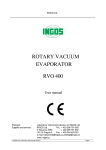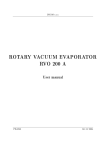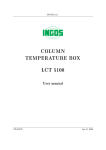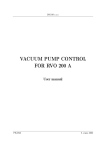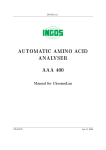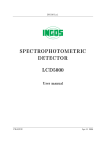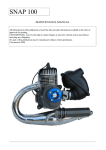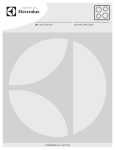Download User manual RVO004
Transcript
INGOS Ltd. ROTARY VACUUM EVAPORATOR RVO 004 User manual PRAGUE INGOS Ltd. Laboratory Instruments division April 11 2006 Page 1 Producer : Laboratory Instruments division of INGOS Ltd. Supplier and service : INGOS Ltd. K Nouzovu 2090 143 16 PRAGUE 4 CZECH REP. Tel: +420 296 781 683 +420 296 781 692 Fax: +420 244 403 051 e-mail:[email protected] [email protected] (c) INGOS 2006 INGOS Ltd. Laboratory Instruments division Page 2 INGOS Ltd. Laboratory Instruments division Page 3 1. INTRODUCTION 1.1 Apparatus use and specifications The RVO 004 Standard and RVO 004 Control rotary vacuum evaporator is used for evaporation under low pressure at a preset temperature of the heating bath (if the bath is a part of the delivery) and under permanent and in advance specified stirring of the evaporated solution. The exhausted vapours condense in a vertical cooler and are collected in a flask. This ensures that the evaporated solution cannot be damaged and therefore impaired. RVO 004 Standard is equiped by water bath with the thermostatic temperature control. RVO 004 Control is equiped by water bath with the electronic temperature control. 1.2 Technical characteristics Evaporating flasks ........................ 20 – 4000 ml Rotation speed ........................... 10 to 200 rpm Bath temperature Standard ...... 35°C - 95°C Regulation accuracy ................... ±5°C Bath temperature Control ........ from the ambient temperature +5°C – 100°C Regulation accuracy Control ...... ±2°C Power supply ................................230V, ±10%, 50Hz Power input ................................ max.24 VA Bath input .................................. max.2000 VA Weight without glass ................. 8 kg Dimensions (w x h x d) .............600 x 950 x 390 mm (including glass) 1.3 Symbol Explanation - hot surface INGOS Ltd. Laboratory Instruments division Page 4 2. TECHNICAL DESCRIPTION The instrument consists of a stand, head with rotating housing, cooler's holder, pipe, adapter of the bulb condenser, flask with a ball joint, round-bottomed flask, inlet pipe with a valve, flexible and fixed clamp. For complete list of basic accessories see paragraph 7.1 1. 2. 3. 4. 5. 6. Fitting –Vacuum connection Fitting – Cooling water connection Condenser (cooler) Filling pipe with a valve Fixed clip Receiving flask 1000 ml with ball joint socket 8. Stand 9. Rotation controling 10. Rotation casing Head 11. Round bottom flask , joint NZ29/32 12. Fixing screw 13. Heating bath Fig. 1. Location of individual parts of RVO INGOS Ltd. Laboratory Instruments division Page 5 3. STARTING OF OPERATION 3.1 Unpacking of the apparatus Remove the instrument from the transport packing, check the instrument surface and all the items according to the delivery note. Please contact the manufacturer or your dealer in case of instrument damage or a missing part. Notification: Coat the glass joints with silicone vaseline prior to assembly. 3.2 Apparatus assembly 1. Screw the bar of the cooler's holder into the nut in the head with the rotating housing, insert the housing with the openings and grooved nuts and the cooler's holder itself. 2. Insert the pipe into the head with the rotating housing from the side of the heating bath until the pipe joint snaps behind the ring in the rotating housing. Insert the arresting rod into the opening in the rotating housing and tighten the nut of the housing. 3. There is a fixed housing with a nut on the opposite side of the head with the rotating housing. Unscrew nut (2), insert on the recessed part of the ball adapter (1) and insert securing ring (3) until it snaps behind the recessed part of the ball adapter. Check if Gufero packing (4) coated with silicone vaseline is placed by the open side outside the recess. Check if flat packing (5) is inserted in the housing and carefully insert the ball adapter with Gufer and the nut on glass pipe (7). Insert the ball adapter until the end stop and tighten it carefully with nut (2). The half-ball joint of the ball adapter points downward. 4. Coat all the joints on the other glass parts finely with silicone vaseline. 5. Insert the cooler into the joint in the top part of the ball adapter and also into the cooler's holder. The top cooler's outlet serves for connecting the subpressure source, other outlets are for cooling water. 6. Attach the flask with the ball joint to the ball joint using the fixed clamp and tighten it. 7. Insert the round-bottomed flask on the pipe and secure with the flexible clamp. 8. Insert the inlet pipe with the cock (cock is closed) into the ball adapter. 9. Connect the bushing. 10. Pour water into the heating bath; adjust the end stop of the stand for the roundbottomed flask being immersed in the liquid. The maximum amount of the liquid is approximately 20 mm below the edge of the heating bath. Notification: A glass part with a visible crack or another defect must not be used! INGOS Ltd. Laboratory Instruments division Page 6 1. 2. 3. 4. Ball adapter Nut Bead-type securing ring Gufero sealing 35/22/10 5. Flat sealing 6. Housing 7. Suck pipe Fig. 2a. Ball adapter sealing INGOS Ltd. Laboratory Instruments division Page 7 1. 2. 3. 4. Ball adapter Nut Bead-type securing ring Gufero sealing 35/22/7 5. Flat sealing 6. Housing 7. Suck pipe 8. Scraper ring (chemical resistant) Fig. 2b. Ball adapter sealing (chemical resistant ) INGOS Ltd. Laboratory Instruments division Page 8 1. 1. 2. 3. Ball adapter Nut Bead-type securing ring PTFE sealing 5. -----6. Housing 7. Suck pipe Fig. 2c. Ball adapter sealing (chemical resistant) 3.3 Apparatus control The instrument is put into operation by connecting the network switch. The round-bottomed flask starts rotation after turning on the switch. The speed of rotation is controlled by the rotary knob. The height of immersion into the heating bath is arrested with a bolt on the telescopic stand. The bath temperature setting at version Standard is by using the thermostat scroll and at version Kontrol by degrese scale. 4. MAINTENANCE 4.1 Apparatus maintenance Do not leave the evaporator surface contaminated from corrosive substances. It could damage the evaporator coating. Clean the contamined surface with a clean soft cloth. The cloth may be moistened but not wet. It is also possible to use ordinary washing means for cleaning purposes. It is forbidden to clean the heating bath with the means which could spoil its smooth surface. In case of sediments of furning,impurities, particulates of water rusts ,use the cleaning compounds for cleaning of furning or mellow solution of HCL. In process of cleaning use the protective means recommended by producer of INGOS Ltd. Laboratory Instruments division Page 9 applied cleaning compounds. Caution: Disconnect the apparatus from the network while cleaning it with a wet cloth! 4.2 Sealing replacement Disassemble the condenser, remove the releasing pipe with the valve, remove the ball-andsocket ground joint flask, release the nut of the ball adapter and carefully remove the actual adapter. Release the gufero sealing, clean the ball adapter, slightly apply silicone Vaseline onto the new sealing and mount it into the ball adapter. The sealing cavity faces out of the ball adapter. If necessary, replace also the flat sealing between the ball adapter and the head fitted with a rotary casing. Perform the assembly according to the point 3.2. Apply a light layer of silicone Vaseline to the gufero sealing approximately after 80 operation hours (more often if necessary). 5. DEFECTS AND TROUBLESHOOTING 5.1 Leakage The main cause of leakage is usually an incorrect sealing assembly. At first you should check that all joints have been installed correctly. If it is the case, disassemble the glass and verify the condition of the ball adapter sealing and flat sealing, if necessary replace them. Carefully assemble according to the instructions, switch the rotation ON and start the vacuum pressure up. 5.2 Other failures The instrument does not react after being turned on. Check the fuse or replace for a new one of the same parameters, as appropriate. Check that the rotation is not hindered (turning by hand), turn on and off the network switch. The window of the rotation key is flashing, rotating parts are not moving. Ensure that Rotation blocking knob is set to ”Unlock” and than press rotation key again. The window of the rotation key is flashing. Check that there is not anything which could impede the flask from its rotation (manually), switch the mains switch OFF and ON again. The bath no warms.Put out the socket plug of the bath and let the bath cool down. Plug in again fill up the water or oil and set required temperature. 6. SAFETY AND OPERATION CONDITIONS 6.1 Operation safety Securing the rotation of the evaporated sample: Overcurrent protection of the driving motor. If the resistance against rotation exceeds a specified limit, the power supply of the driving motor is disconnected. Securing the bath heating: With thermal fuse during overheating above 200°C. INGOS Ltd. Laboratory Instruments division Page 10 6.2 Operation conditions The instrument is designed for work under standard laboratory conditions at temperatures from 10 to 30°C and air humidity to 80°C.It is forbidden to handle a bath heated to a temperature higher than 40°C. Attention! Be especially careful when replacing a round-bottomed flask after increasing the concentration of the evaporated sample. If the flask cannot be removed easily from the cone, carry out further operation only after cooling the bath. Caution! If you are replacing the round-bottom flask after the vaporized solution has become thicker, pay particular attention and if it is not possible to remove the flask easily from the cone, carry out any other handling only after the cooling of the bath. Caution! If you use oil as the filling of the heating bath, the heating bath must be properly dried before its being filled. 7. ACCESSORIES AND SPARE PARTS 7.1 Basic accessories (comes with evaporator) Inlet cord Glass assembly Round bottom flask (1000, 2000 ml) NZ29/32 Receiving flask (1000 ml) KS 35/20 Suck pipe Ball adapter Vertical condenser Filling pipe with a valve 3 pieces of GL14 connection fitting Sealing: gufero sealing 35/22/10 (Fig. 2a, pos. 4), flat sealing (Fig. 2a, pos. 5) 7.2 Other accessories 7.2.1 Glass accessories (Fig. 3) 4SKL0021 4SKL0025 4SKL0022 4SKL0023 4SKL0004 4SKL0003 4SKL0012 4SKL0017 4SKL0024 4SKL0006 4SKL0034 4SKL0005 4SKL0033 Evaporating flask 50 ml, joint NZ29/32 Evaporating flask 100 ml, joint NZ29/32 Evaporating flask 250 ml, joint NZ29/32 Evaporating flask 500 ml, joint NZ29/32 Evaporating flask 1000 ml, joint NZ29/32 Evaporating flask 2000 ml, joint NZ29/32 Evaporating flask 4000 ml, joint NZ29/32 Receiving flask 250 ml, joint KS35/20 Receiving flask 500 ml, joint KS35/20 Receiving flask 1000 ml, joint KS35/20 Receiving flask 2000 ml, joint KS35/20 Vertical condenser Diagonal condenser INGOS Ltd. Laboratory Instruments division Page 11 4SKL0020 4SKL0001 4SKL0002 4SKL0008 4SKL0009 4SKL0010 4SKL0019 4SKL0018 4SKL0011 4SKL0014 4SKL0015 4SKL0016 4SKL0035 RO3212 Dry ice trap Filling pipe with a valve - short Filling pipe with a valve - long Ball adapter Flask 100 ml, joint NZ14/23 Flask 250 ml, joint NZ14/23 Spider with 3 sleeves NZ14/23 (max. flask 250ml) Spider with 5 sleeves NZ14/23 (max. flask 100ml) Spider with 6 sleeves NZ14/23 (max. flask 20ml) Foam trap NZ29/32 - NZ14/23 Foam trap NZ29/32 - NZ29/32 Test tube 20ml, joint NZ14/23 Adapter NZ29/32 - NZ14/23 Suck pipe 7.2.2 Spare parts, other accessories RO1520 1TOO0007 1TG24524 1TOO0009 1TOO0010 1TOO0008 RO1080 RO1041 4SKL0026 4SKL0027 90000013 5HAD0003 90000036 90000044 Fuses: Protection bath cover Gufero sealing 35/22/10 (Fig.2a) Flat sealing Gufero sealing 35/22/7 (Fig.2b) Scraper ring Sealing PTFE (Fig.2c) Fixed clip (for KS32/20) Elastic clip (for NZ14/23) Straight fitting GL 14 Cap nut GL 14 Tubing coupler PA Vacuum tubing Vacuum pump ( VM20D recomended) Spare diphragms and sealing for VM20D Heating bath stainless steel T 200 mA INGOS Ltd. Laboratory Instruments division Page 12 Fig. 3. Glass accessories overview INGOS Ltd. Laboratory Instruments division Page 13 8. CONCLUSION 8.1 Carrying out of repairs All warranty and after-warranty repairs shall be carried out by the manufacturer or by the organization authorized by them. If the delivery note does not state otherwise, contact the distributor for any repair requirements. 8.2 Warranty A warranty will be provided for the product by the manufacturer for a period of one year after handing it over to the buyer. The instrument may be used only in the manner described in these instructions for use. The instrument must not be used in a manner different from that indicated in these instructions, otherwise the safety of operation may be affected. The manufacturer does not accept responsibility for damage arising by non-fulfilment of the requirements of these instructions. 8.3 Waste disposal When the instruments operating life is over dispose it in respect to valid regulations, also it can be returned to the vendor or producer for liquidation. Warning: Instrument contains parts (PCB’s) which are rated as hazardous waste. INGOS Ltd. Laboratory Instruments division Page 14 9. TABLE OF CONTENTS 1. INTRODUCTION .................................................................................................................... 1.1 Instrument use and specification ................................................................................... 1.2 Technical information ....................................................................................................... 1.3 Symbol Explanation .......................................................................................................... 2. 3. TECHNICAL DESCRIPTION ................................................................................................ 5 PUTTING INTO OPERATION ............................................................................................... 6 4. 5. 6. 7. 8. 9. 4 4 4 4 3.1 Unpacking the instrument ............................................................................................. 6 3.2 Mounting the instrument ............................................................................................... 6 3.3 Operating the instrument ............................................................................................... 9 MAINTENANCE ....................................................................................................................... 9 4.1 Maintaining the instrument surface ............................................................................. 9 4.2 Replacing the packing .................................................................................................... 10 DEFECTS AND TROUBLESHOOTING .............................................................................. 10 5.1 Leak (required pressure is not obtained) .................................................................... 10 5.2 Other failures .................................................................................................................. 10 SAFETY AND OPERATION CONDITIONS ..................................................................... 10 6.1 Safe operation .................................................................................................................. 10 6.2 Operating conditions ...................................................................................................... 11 ACCESSORIES AND SPARE PARTS ................................................................................ 11 7.1 Basic accessories (comes with evaporator) .................................................................. 11 7.2 Other accessories ............................................................................................................ 11 7.2.1 Glass accessories ................................................................................................. 7.2.2 Spare parts, other accessories ........................................................................... CONCLUSION ......................................................................................................................... 8.1 Carrying out of repairs ................................................................................................ 8.2 Warranty.......................................................................................................................... 8.3 Waste disposal .............................................................................................................. TABLE OF CONTENTS ....................................................................................................... 9.1 List of picturtes and tables .......................................................................................... 11 12 14 14 14 14 14 14 9.1 List of picturtes and tables Fig. 1. Location of individual parts of RVO ..................................................................................... 5 Fig. 2. Ball adapter sealing - section view (a-c)........................................................................ 7-9 Fig. 3. Glass accessories overview .......................................................................................................... 13 INGOS Ltd. Laboratory Instruments division Page 15
















